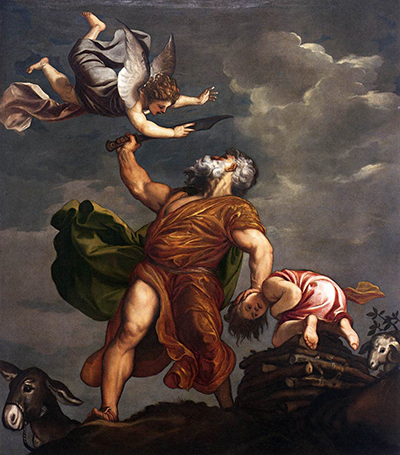The Sacrifice of Isaac was originally painted as part of the ceiling artwork for the Santo Spirito church in Isola in 1542.
It was a companion piece to two other religious paintings for the same church ceiling; Cain and Abel, and David and Goliath. The painting now resides in the sacristy of Santa Maria della Salute (Saint Mary of Health) Basilica in Venice.
This painting is a classic example of mannerism; the exaggeration of proportions and the use of unnatural angles and perspectives to create a striking look in contrast to the naturalist styles of the high renaissance. The perspective and foreshortening are even more unusual than normal in this painting because, of course, it was designed to be viewed from below. Mannerism is often exemplified in the drama and tension held within the paintings, and Sacrifice is no exception.
Roiling clouds with a literal silver lining are a background to this stark and almost tragic scene. Abraham has been poised to kill his son Isaac, who is looking downwards, almost directly towards the viewer as if beseeching them to help him. Abraham is large and muscular, emphasising his power over the tiny child even though he holds him with only one hand. The angel faces Abraham directly; they are locked eye to eye as the diminutive religious messenger stays his hand with a touch of delicate fingers. The composition has the figures locked in an eternal spiral. The body of the angel twists in the air just as Abraham’s body spins around to see who has stopped him in his act of devotion. This gives a fluidity to the painting which only adds to its mesmerising quality.
All three of the paintings for the Santo Spirito church were of uncomfortable and difficult situations. They each contained a violence that was almost shocking yet also familiar, due to the famous biblical tale they told. The violence of Sacrifice is tempered by the staying power of the angel. Though Abraham would have killed for his god, ultimately he does not, so the overriding theme of this painting becomes hope, and God's mercy.
It is thought that Flemish artist Peter Paul Rubens was inspired greatly by Titian's ceiling works. English King Charles I, a great patron of the arts, commissioned Rubens to design and paint the ceiling of the Banqueting House at the Palace of Whitehall and Titian’s influence is evident in the completed works here.
Isaac and Abraham have been depicted many times, most notably by Caravaggio and Rembrandt. Titian's use of light, colour, and composition makes this well-told tale come alive with energy and tension. The innocence of Isaac contrasts with the devotion yet uncertainty of Abraham and the omniscient divinity of the angel. A powerful painting that turns terror into hope.




